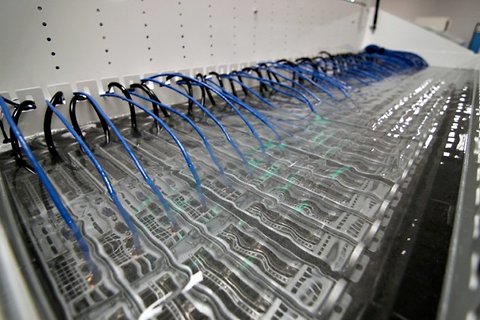 Green RevolutionIntel submerged computer servers in mineral oil to cool them and reduce energy consumption of a data center.
Green RevolutionIntel submerged computer servers in mineral oil to cool them and reduce energy consumption of a data center.
When they’re using their smartphones or tapping away on laptops, few people pause to think about the enormous amount of energy needed to power the data centers that store and deliver the information in all those e-mails and on Web sites and Facebook pages.
But maybe we should. A recent study by Pike Research estimated that about 1.5 percent of all electricity generated worldwide goes to power data centers. The attendant greenhouse gas emissions, some 188 million tons of carbon dioxide per year, match the emissions of about 33 million passenger vehicles.
Most of this energy goes to power fans, air conditioners and chillers to circulate air and remove the heat generated by the data centers’ computers, which must operate below a certain temperature. So it’s no surprise that companies that build and maintain data centers focus on how to cool things down more efficiently.
Moving to a cooler Nordic climate makes sense for some, as The Times reported last spring. Google opened a data center in Finland last year that uses cold seawater for the building’s air-cooling systems. And Facebook recently announced plans to build a center in Sweden that will draw in cool air from outdoors.
But Intel, the chip maker, has been experimenting with a less obvious approach: cooling its servers by submerging them in mineral oil.
The company just completed a one-year trial of specialized oil bath and immersion tanks developed by an Austin-based start-up, Green Revolution Cooling. According to the Texas company’s chief executive, Christiaan Best, the equipment involves slight modifications to off-the-shelf computers servers, like removing internal fans. Using oil immersion rather than circulating air can reduce the amount of energy required to cool the computers by 10 to 20 percent, the company estimates.
It seems counterintuitive to dunk your electronic devices in liquid to cool them off, but Mr. Best noted that early supercomputers relied on liquid cooling technologies. (Remember the Cray 2 supercomputer, nicknamed “Bubbles”??)
“The oil serves as a much better conductor of heat away from the computer components compared to air cooling,” Mr. Best said in a telephone interview, “and because the oil does not conduct electricity, the components won’t short out or damage.”
Intel also found that no computer components — processors, hard drives etc. – were damaged from the yearlong immersion in mineral oil.
Green Revolution Cooling is one of a handful of start-ups hoping that oil cooling will catch on. And while Mr. Best is eager to tout the product’s environmentally positive aspects, he expects that savings on energy costs, which can account for 50 percent of total operating costs at a typical data center, will hold the biggest appeal.
“As much as we’d like to save energy for the sake of saving energy, no one will buy it unless it saves money and is cheaper than the alternative,” he said.
Article source: http://green.blogs.nytimes.com/2012/09/06/cooling-a-computer-server-with-mineral-oil/?partner=rss&emc=rss
Speak Your Mind
You must be logged in to post a comment.